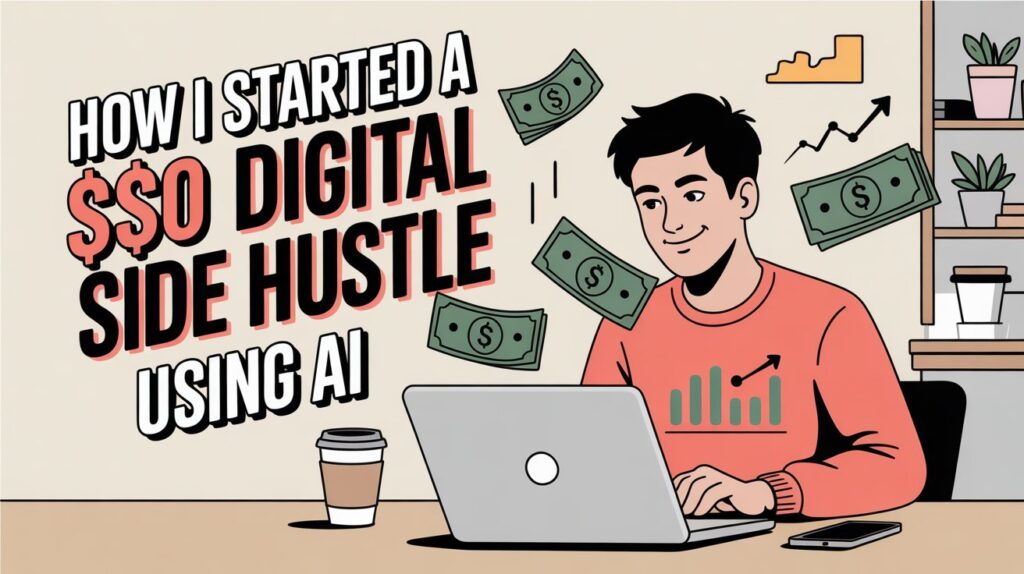I still remember the day I told myself, “What if I try to build an online business with no money at all?” No paid tools. No ads. Not even a domain. Just me, my computer and free resources and figuring things out.
It sounded almost impossible. But 2025 makes it a different game. With the rise of free AI tools and ns-code platforms, starting with zero budget is no longer a dream; it is a reality that I experienced and have built on piece by piece.
In this article, I’m sharing my exact journey of how I turned a $0 Digital Side Hustle Using AI. I didn’t just read about this; I tested, failed, adjusted, and eventually made it work.

Why I Chose Digital Products?
When I started brainstorming ideas, the first question was: “What can I sell that doesn’t need money up front?”
Physical products were out. Investment was required in inventory, shipping, and packaging. Freelancing was an option, but that meant trading time for money, and my goal was passive income.
That’s when I learned how powerful digital assets could be.
A digital asset is basically something you create once, and it can be sold over and over again at no additional cost. Anything from templates, an ebook, planners, courses, or even a spreadsheet that solves a problem.
The beauty? There’s no stock to run out of, no delivery delays, and no overheads. I realized this was my best bet to start a $0 digital side hustle.
Learn how AI will look like in 2030? Or What industries will replace humans by AI in future?
Step 1: Finding the Right Idea
This was the scariest part for me. I used to think, “I’m not an expert in anything. Why would someone pay me?”
But here’s what I learned: you don’t need to be a professional, you just need to be one step ahead of someone else.
I proved this to myself when I turned something as ordinary as my spreadsheet skills into a product idea. Friends always asked me to fix their budgets or create trackers.
That was my lightbulb moment: If people keep asking me for help, there must be a wider audience who needs the same thing.
To test more ideas, I used:
- YouTube comments (people asking the same “how do I…” questions)
- Reddit threads in niches I cared about
- Amazon reviews (especially the 3-star ones where people complain about missing pieces)
- And yes, I even asked AI tools to suggest beginner-friendly ideas based on my hobbies.
When I cross-checked those ideas with real problems people were voicing online, I found my first winner.
Step 2: Building an Audience for Free
Most people go to platforms like eBay or Amazon, he said, but when I started listing things there, I think I realized within a month I was invisible. The competition was fierce, with everyone trying to be the lowest-priced seller.
So instead, I focused on creating an audience that I controlled. My choice? YouTube.
Now, I’m not a filmmaker. My first videos were shaky, my voice sounded odd, and the edits were minimal. But here’s the thing, I wasn’t trying to wow you with fancy visuals. I was just trying to help.
I promised myself one video per week in my niche. Each video was related to solving some small problem, for example:
- How to set up a basic budget in under 10 minutes
- The tools I used to design my first freebie
- Mistakes I made trying to sell digital products
Gradually, my channel began to draw the right audience. YouTube became my traffic source, and I haven’t paid a rupee to promote since.
Step 3: Creating a System That Sells for Me
This was the breakthrough. I didn’t want views, I wanted sales. And to do that, I created a system that runs 24/7, even when I’m not online. Here’s how I set it up:
- Created a freebie: My first freebie was a basic checklist. Nothing fancy, but it solved the quick problem. I designed it on Canva (free).
- Built a landing page: I used Systeme.io’s free plan to serve a page where people could download the checklist in return for their email.
- Set up an email sequence: I wrote 5 small emails where I did nothing more than to introduce myself, provide some value, and then lightly pitch my paid offer.
That meant that each YouTube video I shared directed viewers to my freebie. From there, the process took over, providing value first, getting trust and, in the end, making sales.
Here’s what’s interesting… Once I built it, it kept running automatically.
Step 4: My First Paid Product
Instead of guessing at what to sell, I did something smarter: I went to my audience.
After my email list crossed about 100 people, I sent a basic Google Form containing a single question:
“What’s the #1 problem you still struggle with in [niche]?”
The answers were eye-opening. I could see that people didn’t want just a checklist; they wanted a tool they could actually use, a template that could be plugged into everyday life.
So I launched my first digital product: a budgeting template pack with brief video instructions. It didn’t take me weeks. In truth, I built it in a matter of days, less than 10 days.
I priced it at $99 to start. And when I got my first sale from a stranger, I knew this system actually worked.
Step 5: Scaling Beyond the First Sale
The moment you get proof of concept, the game changes. My next challenge was: How do I turn this trickle into $500, $800, or even $1000k a month? Here’s what I focused on:
- Posting more YouTube videos: Each one became a traffic magnet.
- Adding more products: When users loved the budget template, I introduced a premium version with additional functionalities.
- Affiliate marketing: I began recommending the free tools I’d been using (such as Systeme. io, Canva, and even the microphone I upgraded to). Each time someone registered through my link, I’d get a little commission.
- Experimenting with bundles and upsells: I also created a bundle package with my freebie and the premium version of the Starter-Kit at a reduced price. Sales went up instantly.
What surprised me most was that scaling didn’t mean working 10x harder. It was not reinventing the wheel; it was optimizing the system that I had already built.
What I Learned From Doing This $0 Digital Side Hustle Using AI?
- Perfection is the enemy. The first freebie I offered was a not-so-great one, but it did get me some downloads. My first video was not pretty, but it helped me earn trust.
- People buy clarity, not length. A short template is more powerful than a 100-page ebook.
- Owning your audience matters. Social media can disappear overnight, but your email list is yours forever.
- Ask, don’t assume. My best product ideas came directly from the people already following me.
FAQs
Yes. Many YouTube creators succeed with screen recordings, voiceovers, or faceless animations. It’s about the worth, not the face.
For me, it was:
1) Canva (design)
2) ChatGPT (idea drafts and content outlines)
3) Systeme.io (landing pages + email)
4) Google Forms (audience research)
My first email opt-ins came within 2 weeks of posting videos. I made my first sale after 6 weeks. Consistency was the secret.
Final Thoughts
Starting a $0 digital side hustle in 2025 isn’t just possible; I’ve done it. There is no need for a big budget, fancy equipment or expert status. You simply need a problem-solving attitude, free tools and the guts to make a start on something a little messy.
The first win may seem insignificant, like someone downloading your freebie or a stranger buying your $99 template. But let me tell you, that moment is everything. It’s proof that your ideas have value.
From there, it’s simply about repeating the process, one small step at a time.
So if you’ve been waiting for a sign, here it is. Start today with no money, no excuses, and a plan that works.
Also, friends if you are still not using AI, then you must start using it if you don’t want to be repalced by AI. So, just follow the future AI trends and keep yourself updated.

